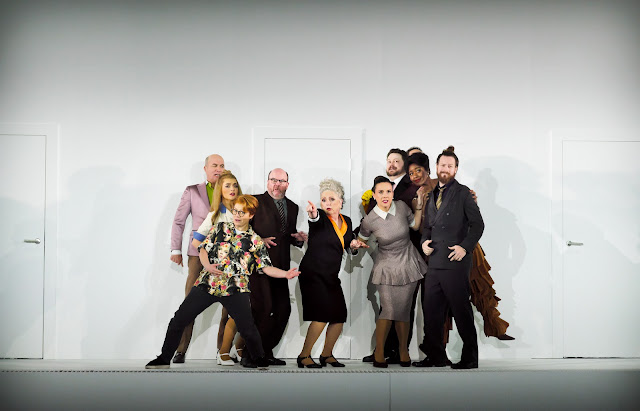 |
| Mozart: The Marriage of Figaro – English National Opera, 2025 (Photo: Zoe Martin) |
Mozart: The Marriage of Figaro; Mary Bevan, David Ireland, Nardus Williams, Cody Quattlebaum, Hanna Hipp, director: Joe Hill-Gibbins/Jenny Ogilvie, conductor: Ainārs Rubiķis; English National Opera at London Coliseum
Reviewed 5 February 2025
Barely seen first time around, Joe Hill-Gibbins production makes a welcome return, telling the story with humour, yet not missing the essential serious elements and with a strong ensemble of vivid performances
Director Joe Hill-Gibbins production of Mozart’s The Marriage of Figaro debuted in Wuppertal in 2019 and then English National Opera presented it at the London Coliseum for a single performance in March 2020 [see my review] then COVID closed theatres down; the activities of La folle giornata, the crazy day at the Almaviva’s palace perhaps an apt metaphor for our crazy times. Now the production is back, with a largely new cast.
We caught the opening performance on 5 February 2025 of English National Opera‘s revival of Mozart’s The Marriage of Figaro directed by Joe Hill-Gibbins with Jenny Ogilvie as associate director/movement director, conducted by Ainārs Rubiķis. Mary Bevan was Susanna, David Ireland [whom we recently saw in the role at Garsington, see my review] was Figaro, with Nardus Williams as the Countess, Cody Quattlebaum as the Count, Hanna Hipp as Cherubino, Neal Davies as Dr Bartolo, Rebecca Evans as Marcellina, Hubert Francis as Don Curzio/Don Basilio, Ava Dodd as Barbarina and Trevor Eliot-Bowes as Antonio. Sets were by Johannes Schütz with costumes by Astrid Klein. The English translation was by Jeremy Sams.
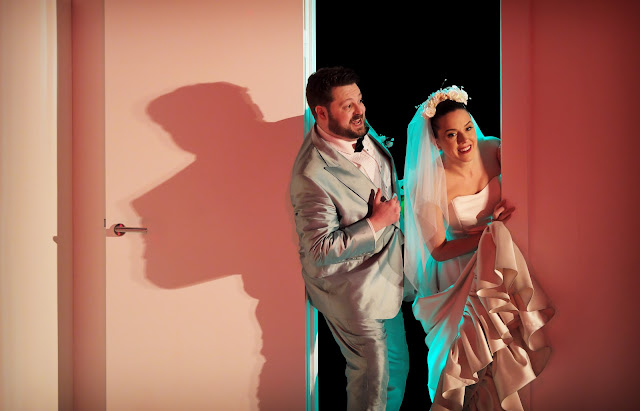 |
| Mozart: The Marriage of Figaro – David Ireland, Mary Bevan – English National Opera, 2025 (Photo: Zoe Martin) |
Schütz’ set is a basic white box which has the advantage of providing the right sort of aural support for the singers. That it has an array of doors is an indication that Hill-Gibbins takes the farce elements of the opera seriously, this is a production with a lot of opening and closing of doors, as well as hiding behind them. The advantage is that in the Act One and Act Two finales, the action can be fast, furious and funny whilst being just on the right side of unbelievable. These scenes are tricky to make work if you aim at pure realism.
The disadvantage of the set became obvious at this revival when we sat, not in the stalls but in the dress circle. For the more complex scenes, including the chorus in Act Three, Hill-Gibbins shows us the stage under the box, the action happening around it, breaking the fourth wall somewhat. But from the dress circle sight-lines were poor, the chorus for instance was partially hidden by the raised box itself. Issues that should have been ironed out early in the planning stage.
It is a very physical production, and Hill-Gibbins and Ogilvie’s use of stylised movement during the overture and in the ensembles, gave the piece a sense of physical theatre. It was funny, without actually sending up the characters. Hill-Gibbins successfully does the balancing act, and these are real people doing funny things. It was, perhaps, a production lacking real tenderness except for one or two moments. Individually Mary Bevan and David Ireland were superb as Susanna and Figaro, but their relationship seemed slightly too business-like.
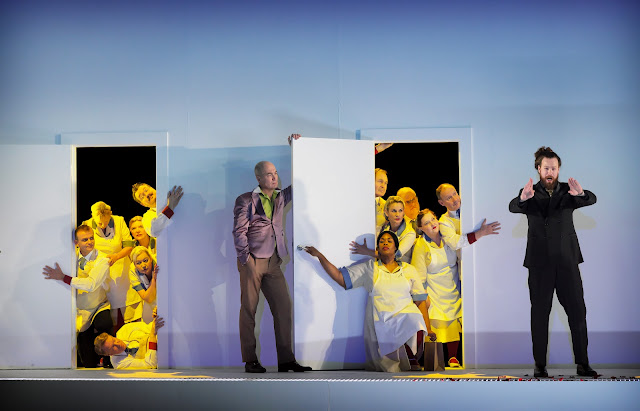 |
| Mozart: The Marriage of Figaro – Hubert Francis, Cody Quattlebaum – English National Opera, 2025 (Photo: Zoe Martin) |
Ireland made an engaging and surprisingly serious Figaro, any comedy from the character woven into the rest of the vivid action. This made Ireland the strong, sober focus. His anger at the Count in Act One was not too vicious and Ireland took the character in a long arc towards the moments of real jealously in Act Four. As Susanna, Mary Bevan was definitely the lynchpin of the action, facilitating the various elements of the crazy day with poise and a demure face, but not about a bit of self-indulgent gyration when Hanna Hipp’s Cherubino sang his aria as a pop song. By the end Bevan, who sang Susanna’s music so beautifully, had drawn us with her.
Nardus Williams’ Countess was simply a revelation. Looking tall and elegant whatever the situation, this Countess held her melancholy in check yet ravished with her two arias. Williams had a way of drawing focus and she made work Mozart’s device of having a mix of buffo, seria and semi-seria characters together by seeming to draw an environment around her. Yet there was a gleam in her eye too, you sensed that she enjoyed the plotting and this Countess was definitely well on the way to having the baby by Cherubino that happens in Beaumarchais’ third play!
Cody Quattlebaum was very much a laddish Count, his long hair usually drawn up into a man-bun. The Count had a sense of his own self-importance allied to hints of something more bohemian, but with an entitled attitude on him that meant servants were not included in his world. Quattlebaum was vivid in his approach to the text and he made the Count’s recitatives count for a lot, so that this Count was very present. And yet. Quattlebaum never quite made enough of the Count’s nastiness, his vicious underbelly. But this was a notable house debut. His English diction was admirably clear, though his accent seemed to wander somewhat, making this Count somewhat mid-Atlantic.
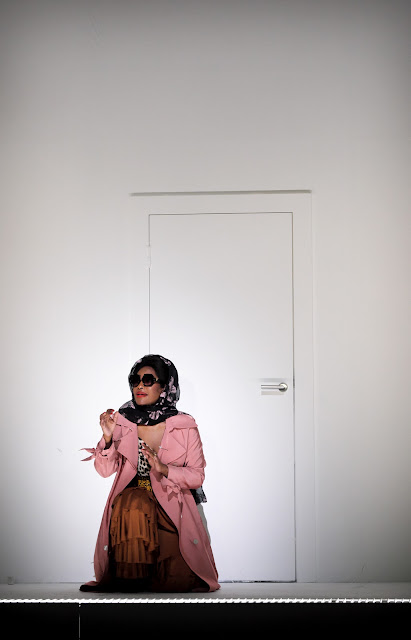 |
| Mozart: The Marriage of Figaro – Nardus Williams English National Opera, 2025 (Photo: Zoe Martin) |
Hanna Hipp returned as the laddish, girl-obsessed Cherubino. Her apt approach to the role was wonderfully all encompassing and as such she emphasised all the, for me, annoying qualities of the character. But they are all there in the music! And that was wonderfully sung, even turning an aria into a pop-song, Hipp made it work. She was physically brilliant as a ‘lad’. We don’t necessarily expect mezzo-sopranos to encompass Cherubino physically but when they do the result is striking.
The smaller characters were all so vividly done, so brilliantly incorporated into the action that they never felt small at all. Rebecca Evans made a poised, self-obsessed Marcellina, never exaggerating her musical line for effect. This was one of those performance where you regretted the lack of Marcellina’s aria in Act Four, even though it holds things up. Neal Davies brought G&S attention to the vividness of words and music to Dr Bartolo, making him a fine foil for Evans.
Hubert Francis was a wonderfully oily Don Basilio, though his Don Curzio was a bit too over the top. Ava Dodd as Barbarina sang her aria elegantly (and in this production it is clear what she has really lost!) and made her other contributions count. Trevor Eliot-Bowes as Antonio was characterful and not too over-the-top-drunk, thank goodness. In the original production, Bartolo and Antonio were doubled, I often wonder why productions do not do that nowadays.
The chorus works hard in this production, getting involved in the physical theatre from the beginning of the overture, creating a visual backdrop for the antics of the protagonists. The wedding scene was, of course, well sung, but the chorus costumes for the women seemed designed to be uniformly unflattering (perhaps that was the point), and the chorus placement meant we never really saw Claire Mitcher and Sophie Goldrick as the bridesmaids.
In the pit, Ainārs Rubiķis drew some fine playing from the ENO Orchestra so that the overture and the major pieces were finely engaging. Overall his conducting felt efficient rather than loving, and I felt that the work needed a little more time to bed in. After all this was Rubiķis’ house debut and doing Mozart in the barn that is the Coliseum is not ideal.
One of the big advantages of this production is that it makes Mozart work in this house. Yes, it is a bit too farcical than some and emphasises the comedy, but never loses sight that these are real people. Jeremy Sams admirably elegant and funny translation was finely delivered and this, combined with Hill-Gibbins’ production meant that the plot and complex action was always clear and well presented. Just what a first time audience needs, yet with plenty to engage old hacks like me.
The blog is free, but I’d be delighted if you were to show your appreciation by buying me a coffee.
Elsewhere on this blog
- My Heart’s in the Highlands: the debut recital from tenor Glen Cunningham mixes Stuart MacRae’s new songs with other composers with ‘Scotland in Mind’ – record review
- Unbearable intensity: musically strong revival of Janáček’s Jenůfa at the Royal Opera with incoming music director Jakub Hrůša on searing form in the pit – opera review
- Schubert’s Birthday at Wigmore Hall: Konstantin Krimmel in overwhelming form, with a welcome group of Carl Loewe too – concert review
- Bruckner’s obsession with death, Scottish Gaelic folk poetry & a grumpy gaboon: Scottish composer Jay Capperauld, Scottish Chamber Orchestra’s associate composer – interview
- Letter from Florida: a study in contrasts, Gounod’s Roméo et Juliette at Palm Beach Opera – opera review
- 1775 – A Retrospective: Ian Page & The Mozartists on terrific form in a deep dive into the sound-world of Mozart’s 1775 – concert review
- Canadian composer Jacques Hétu’s final symphony in a new recording with three of Canada’s major ensembles – record review
- Personal night time musings & reflections: Eight Nocturnes from violist & composer Katherine Potter commissioned by ABC Classic – cd review
- Reynaldo Hahn looks back: Belle Époque in Kaleidoscope Chamber Collective’s programme centred on Hahn’s Piano Quintet – concert review
- Anna Dennis’ Susanna was rightly the main focus of John Butt & Dunedin Consort’s involving account of Handel’s neglected oratorio – concert review
- Home
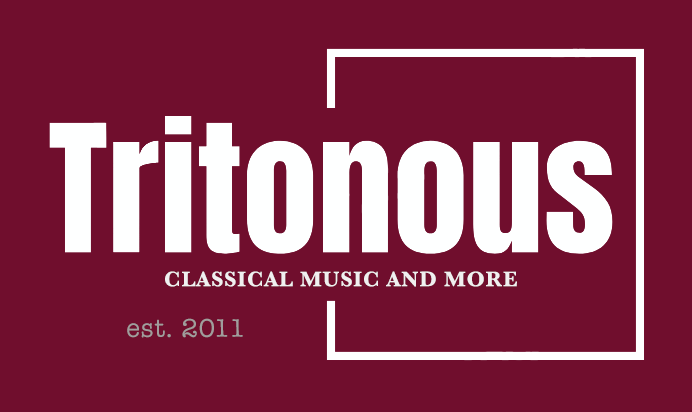

.jpg?w=998&resize=998,665&ssl=1)








